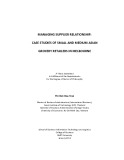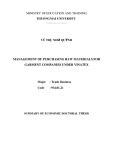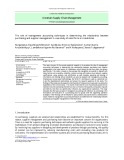
Purchasing and supplier management
-
This study addresses the question: “How do small and medium Asian grocery retailers (SMAGRs) manage their relationships with suppliers in relation to their power positions under different circumstances?” Using the Kraljic matrix as its analytical base, this study incorporates power relations, in addition to the strategic importance and supply risks of the items purchased, as a third dimension to examine the relationship management strategies SMAGRs used to deal with different suppliers.
 299p
299p  runthenight04
runthenight04
 02-02-2023
02-02-2023
 11
11
 3
3
 Download
Download
-
Raw materials management can be defined as the function of business that is responsible for the coordination of planning, sourcing, purchasing, moving, storing and controlling raw materials in an optimum manner so as to provide services to customers at a minimum cost. Raw materials management enables companies to coordinate raw materials-related activities and control total raw materials costs through integrated systems. The raw materials management has the duties as follows: Purchasing; Selecting supplier; Valuation process; Reception process; Technical evaluation; Trade evaluation.
 31p
31p  cothumenhmong6
cothumenhmong6
 17-07-2020
17-07-2020
 35
35
 4
4
 Download
Download
-
The main concern of the current empirical research is to examine the role of management accounting techniques in determining the relationship between purchasing and supplier management in the retail sector of Kazakhstan, which during the last four years, has grown significantly.
 16p
16p  tohitohi
tohitohi
 22-05-2020
22-05-2020
 35
35
 3
3
 Download
Download
CHỦ ĐỀ BẠN MUỐN TÌM















